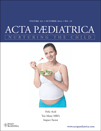Lactate dehydrogenase in hypothermia-treated newborn infants with hypoxic-ischaemic encephalopathy
Abstract
Aims: We investigated whether plasma lactate dehydrogenase (LDH) predicts outcome in hypothermia (HT)-treated term infants with moderate/severe hypoxic-ischaemic encephalopathy (HIE) and additionally whether LDH differs between infants with evidence for acute and nonacute perinatal insults and postnatal collapse (PNC).
Methods: Data from HT-treated infants with HIE (n = 39) were analysed retrospectively. Adverse outcome was defined as a Mental and/or Psychomotor Developmental Index (Bayley Scales of Infant Development II), at 18 months <70. The likely timing of insult onset was assessed in infants with an LDH sample obtained within 6 h of birth or PNC (n = 20).
Results: LDH differed between the favourable/adverse outcome groups at the end of HT treatment (median (IQR) 1540 (1400–1950)U/L vs. 3555 (3003–8705)U/L, (p < 0.01)). All infants (n = 22) with LDH <2085U/L had a favourable outcome while 6 of 11 infants with LDH ≥ 2085U/L had an adverse outcome. LDH in those who died (n = 4) was higher than the favourable outcome group (5090 (2915–12222)U/L, (p < 0.01)) but sampled earlier. Early LDH differed significantly (p < 0.01) between infants with evidence for acute or nonacute insults or PNC.
Conclusion: These results offer a biomarker, with high negative predictive value in the assessment of outcome in HT-treated term infants, needing prospective validation.




